#maritime reconnaissance aircraft
Explore tagged Tumblr posts
Text

Martin P4M maritime reconnaissance aircraft from USN VP-21 over the Patuxent River circa 1950
#Martin#P4M#P4M-1#Mercator#Navy#maritime reconnaissance aircraft#Military aircraft#reconnaissance aircraft
50 notes
·
View notes
Text
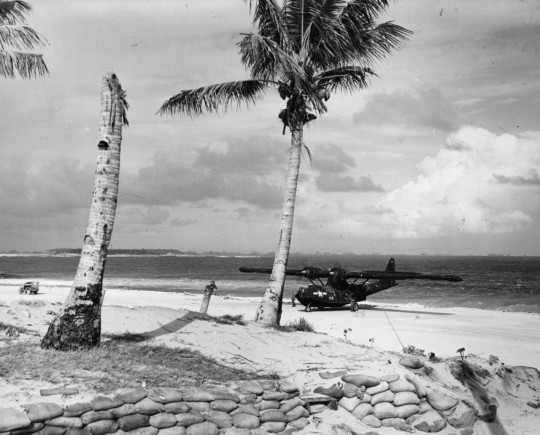
'Black Cats on the Beach'
Consolidated PBY-5A Catalina sur une plage de l'atoll d'Ulithi – Guerre du Pacifique – Iles Carolines – 13 mars 1945
©Naval History and Heritage Command – NH 309720
#WWII#guerre du pacifique#pacific war#aviation militaire#military aviation#hydravion#flying boat#hydravion de reconnaissance maritime#maritime reconnaissance aircraft#consolidated pby catalina#pby catalina#catalina#iles carolines#caroline islands#13/03/1945#03/1945#1945
10 notes
·
View notes
Text


NP-3D | 150521 (1963) | #P3 #Aviation #Navy
Age of Extinction, the final billboard running amuck in the plains of Oxnard 🌅
•
•
@BranomJaden via X
#np-3D Orion#lockheed aviation#maritime patrol#reconnaissance#aircraft#ASW#aviation#navy#us navy#cold war aircraft
16 notes
·
View notes
Text
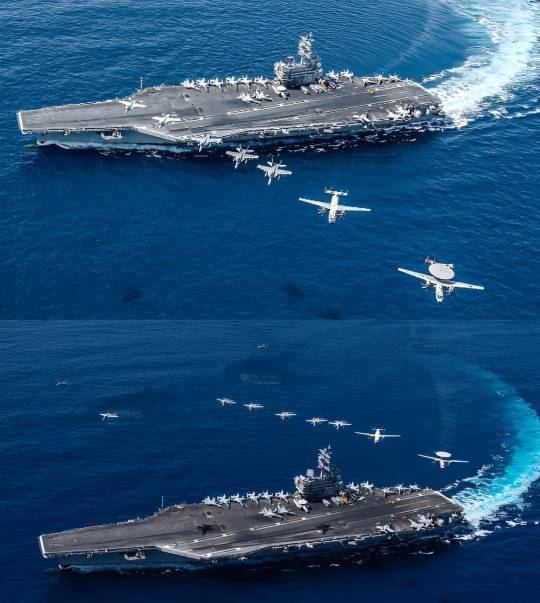
How powerful is a U.S. aircraft carrier?
A U.S. Navy aircraft carrier is a large warship designed to serve as a mobile airbase for naval aviation. It is the centerpiece of a carrier strike group (CSG) and plays a crucial role in projecting power, protecting maritime interests, and providing humanitarian assistance worldwide.
Key features of a U.S. Navy aircraft carrier include:
Flight Deck: The carrier's flight deck is where aircraft take off and land. It is equipped with catapults for launching fixed-wing aircraft and arresting gear to catch aircraft on landing. The flight deck is one of the busiest and most dangerous places on the ship during flight operations.
Hangar Deck: Below the flight deck is the hangar deck, where aircraft are stored, maintained, and prepared for flight operations. It provides sheltered storage for aircraft and equipment, as well as maintenance facilities and workshops.
Air Wing: The carrier's air wing typically consists of a mix of fighter jets, bombers, reconnaissance aircraft, early warning aircraft, and helicopters. These aircraft provide offensive and defensive capabilities, including strike missions, air superiority, surveillance, and search and rescue.
Command and Control Center: Aircraft carriers serve as command centers for naval task forces, with advanced communication and information systems to coordinate operations. They have the capability to direct air, surface, and subsurface assets in complex operations.
Defense Systems: Carriers are equipped with a variety of defense systems to protect against threats such as enemy aircraft, missiles, and submarines. These include radar systems, anti-aircraft missiles, close-in weapon systems, and electronic warfare capabilities.
Overall, U.S. Navy aircraft carriers are among the most powerful and versatile warships in the world, capable of projecting power, maintaining presence, and providing support in a wide range of military operations.
84 notes
·
View notes
Text
The Mystery of Ghost's Better Half (Simon 'Ghost' Fic)
Gamekeeper! Reader, Groundskeeper! Reader, Ex-MI5! Reader, Stalker! Reader, Naughty! Ghost, Naughty! Simon, Stalker! Reader, Possessive! Reader, Sunshine! Reader, Shy! Reader, Introvert! Reader
A/N: This story features the same Y/N (that’s YOU!!) from How I met your Mother, Midnight Snack Mystery and The Mystery of Who Dressed the LT Like That?
You’ll notice I’ve kept physical descriptions and most of your aesthetic to a minimum—no name, race, or colour—because I want you, the reader, to be able to fully immerse yourself in the story. Imagine it’s you!
That said, I’ve crafted your background and bio to be absolutely awesome. Let’s be real—you deserve to be as amazing as the characters you’re sharing the story with! 💪
For those curious about the timeline, this story takes place WAY before both The Mystery of Who Dressed the LT Like That? and Midnight Snack Mystery. and after How I Met Your Mother. I’ll be putting together a proper timeline for all the chaos soon—stay tuned! Genre: Comedy/Fluff
Summary: Set almost a year into your relationship with Ghost, a casual supermarket run takes an unexpected turn when you bump into Sergeant Kyle "Gaz" Garrick—who also happens to be your former subordinate. As stories unfold and secrets unravel, Ghost discovers there's more to your past than you've let on... and you learn he’s been keeping a few surprises of his own. What starts as a mundane errand turns into a hilariously revealing chapter in your lives together. Some Terms to take note of;
RAF: Royal Air Force – The air force branch of the British Armed Forces, responsible for aerial defense and operations.
UAV: Unmanned Aerial Vehicle – A drone or remote-controlled aircraft used for surveillance, reconnaissance, and sometimes combat, without a pilot onboard.
MI5: Military Intelligence, Section 5 – The British domestic counter-intelligence and security agency, primarily focused on national security, including counter-terrorism and espionage.
SAS: Special Air Service – A special forces regiment of the British Army, known for its expertise in counter-terrorism, hostage rescue, and covert operations.
SBS: Special Boat Service – The Royal Navy’s counterpart to the SAS, specializing in amphibious and maritime operations, including counter-terrorism, reconnaissance, and hostage rescue. RMP: Royal Military Police – The military police branch of the British Army, responsible for maintaining discipline, investigating crimes within the military, and providing security for military operations.
SRR: Special Reconnaissance Regiment – A special forces regiment of the British Army, specializing in covert reconnaissance, surveillance, and intelligence gathering.
MI6: Secret Intelligence Service (SIS) – The British foreign intelligence service, responsible for collecting intelligence from outside the UK, mainly focusing on espionage, counter-intelligence, and security issues abroad.
SCO19/CTSFO: Specialist Crime and Operations/Counter Terrorism Specialist Firearms Officers – A unit of the Metropolitan Police Service responsible for handling counter-terrorism operations and armed responses to incidents involving firearms or other serious threats.
Case Officer – A role within intelligence agencies, such as MI5 or MI6, where the officer is responsible for managing agents or assets, gathering intelligence, and overseeing operations involving covert operations and surveillance.
----------
The supermarket buzzed with quiet chatter and the soft clatter of carts. Simon pushed their trolley with one hand, the other draped over Y/N’s shoulder. Both wore masks—not because they were hiding from the world but because they were both introverts who preferred to keep their faces to themselves.
“Why do we always look like we’re about to rob the place?” Y/N muttered under her breath, glancing at their reflection in the freezer doors.
“Don’t flatter yourself,” Simon replied, his voice dry. “You’d be the worst getaway driver. Too many stops for snacks.”
“Bold words for someone who insisted on two different types of biscuits last week.”
He smirked behind his mask, steering them toward the drinks aisle. “Tea,” he said. “Running low.”
She chuckled softly. “Heaven forbid we face a morning without tea.”
They rounded a corner when a familiar voice stopped them in their tracks.
“LT?”
Simon glanced up sharply to see Kyle Garrick standing a few feet away, looking equal parts amused and bewildered.
“Garrick,” Simon greeted, nodding in acknowledgment.
Kyle closed the distance, clapping Simon’s shoulder in a friendly grip before offering the traditional handshake-bump. “Didn’t think I’d ever catch you out here, sir, in a domesticated way!”
Simon rolled his eyes but let a smirk slip through. “Everyone’s got to eat, mate. Even me.”
Kyle chuckled, but his attention drifted to Y/N, and his expression froze. His eyes widened in disbelief. “No bloody way.”
Y/N blinked, tilting her head. “Kyle?”
“Ma’am!” Kyle’s grin split wide as he snapped a playful salute before pulling her into a hug. “It’s really you!”
Y/N laughed softly, hugging him back. “Look at you, all grown up and out of trouble.”
Simon stood off to the side, arms crossed and brow raised. “Ma’am?” he echoed, his tone skeptical but sharp.
Kyle stepped back from the hug, hands raised as if to placate him. “Relax, LT. Not nicking Mrs Riley.”
“I’m not yet—” Y/N started, only for Simon to cut in.
“She will be,” Simon said matter-of-factly, his voice laced with quiet authority.
Kyle chuckled, shooting Y/N a knowing look. “Fair enough. But seriously, LT, you’ve bagged yourself a legend.” He gestured to Y/N. “This woman was my case officer back when I was just starting out. Pulled me and my team out of more fires than I care to count.”
Y/N winced. “Kyle, don’t.”
But Kyle continued undeterred. “She’s the reason I got placed with the CTSFOs before Price found me. Without her, I wouldn’t be where I am now.”
Simon’s eyes narrowed slightly, the edge in his tone unmistakable. “That so?”
Kyle nodded earnestly. “She didn’t just handle the logistics—she made sure we got in and out in one piece. Always had a knack for knowing when to pull us before things got messy.”
“Kyle,” Y/N interrupted, raising a hand. “Enough. You’re making me sound like a bloody action figure.”
Kyle grinned, sheepish but unapologetic. “Sorry, ma’am.” He turned to Simon, adding, “Go easy on her, LT. She’s earned it. And don’t worry—I won’t tell the lads.”
“Good,” Simon said curtly, his tone clipped but not unkind. “I’ll interrogate her myself. Now, get on with your shopping, Garrick.”
Kyle saluted again, grinning. “Aye, sir.” He turned back to Y/N with a softer look. “We’ll catch up one day, yeah?”
“Yeah,” she said with a faint smile. “Take care, Kyle.”
As Kyle walked off, Simon’s amber eyes fixed on her, curiosity and amusement dancing in their depths. “So,” he drawled, “you’re a legend, are you?”
She groaned, pushing the trolley forward. “Don’t start.”
Simon followed, his tone low and teasing. “You’re my Mrs Riley, and yet I’m only hearing this from Garrick? What else are you hiding, love?”
She sighed, glancing over her shoulder. “Plenty.”
He smirked, a glint of mischief in his eyes. “We’ll sort that later. For now, let’s stock up. Wouldn’t want to run out of biscuits again.”
Y/N muttered something under her breath but let him guide the trolley forward, knowing full well that “later” was going to be anything but quiet.
----------
Back at Simon’s house, the rustle of grocery bags filled the quiet kitchen as Y/N started unpacking their haul. Simon leaned against the counter, arms crossed, his amber eyes fixed on her with that signature intensity she found equal parts alluring and irritating.
“So,” he began, voice low and calm, “how exactly do you know Kyle?”
Y/N sighed, rolling her eyes as she pulled out a loaf of bread and a jar of honey. “He’s just a kid I looked after, that’s all.”
Simon arched a brow. “Looked after? He was going on about saving lives. Sounds a bit more than babysitting, love.”
She set the bread down and shot him a look. “It’s not worth mentioning. Besides, you never asked.”
His brow shot higher, and a hint of amusement flickered in his gaze. “Never asked, huh?”
She shrugged nonchalantly, focusing on the next bag. “What was I supposed to say? ‘Hi, I used to babysit rookie agents and soldiers when they couldn’t keep themselves out of trouble’? Bit of a conversation killer, don’t you think?”
Simon snorted, stepping forward to help as she tried—and failed—to push a box of tea onto the top shelf. His hand brushed hers as he easily slid it into place. “Funny how you leave out that you were apparently some kind of mastermind,” he said, his tone casual but teasing.
She rolled her eyes, but a faint smile tugged at her lips. Then she turned the tables. “I heard Kyle call you ‘LT.’ And since he’s SAS, that means you’re SAS, too, yeah?”
Simon smirked, pulling another bag closer. “And here I thought you knew everything about me.”
“All you told me is you were RAF,” she countered, her arms crossed now. “Are you really going to act smug about not mentioning that detail?”
He set a box of biscuits on the counter and leaned in slightly, his voice dropping an octave. “You never asked. How was I supposed to tell you?”
She snorted, trying to brush past him to grab more groceries, but he moved faster, blocking her path with his broad frame. His eyes glittered with mischief. “Anything else you’ve been keeping from me? Or do I have to wait for Garrick to fill me in again?”
She tilted her head up, glaring playfully. “Oh, I’m sure there’s plenty you don’t know about me.”
“Plenty?” he repeated, feigning surprise. “Should I be worried?”
“Maybe,” she teased, pushing at his chest lightly. “You’ll find out eventually—if you’re lucky.”
Simon caught her wrist, his grip firm but gentle, and pulled her closer. The corner of his mouth curled into a smirk. “Lucky, am I?”
“You might be,” she replied, her tone breezy but her pulse quickening as his thumb brushed her wrist.
“Guess I’ll have to keep asking then,” he murmured, his voice a deep rumble. “Can’t have my Mrs. Riley keeping secrets from me.”
“I’m not—” she started, but he cut her off with a soft kiss, the groceries temporarily forgotten as his teasing turned into something much more serious.
When they broke apart, her breath hitched, and she quipped, “You’re still putting away the rest of those groceries.”
He chuckled, leaning back slightly but not letting her go. “Fair enough. But don’t think you’re off the hook, love. We’ll have another chat about Garrick soon enough.”
“You know, we don’t have to wait until later,” she teased, “might as well start the ‘interrogation’ now.” She raised a brow at him. “But fair’s fair. For every question about me, I get to ask you one. Deal?”
Simon grinned. “Deal.” His voice was steady, but there was an undeniable edge of anticipation as he leaned in, clearly ready for his next round of questioning.
“How do you know Sergeant Garrick?” Simon asked again, now that the gauntlet had been thrown down.
Y/N took a deep breath, her eyes flickering briefly to the side before she met his gaze. “I was a Case Officer for MI5,” she began, her voice steady but with a note of something deeper. “I worked with MI6, the SAS, SBS and SCO19/CTSFO. Gaz was stationed in the Middle East during a critical operation. There was a leak within MI6 that affected MI5, and I had to pull his team out at the last minute.” (A/N: Gaz working in the middle east is actually canon material, you can find it in his bio)
Simon didn’t interrupt, his curiosity piqued.
“Garrick was just starting out, but he was good,” she continued. “His team was in real danger. I saved them—kept them from walking into a shitstorm that would’ve cost them their lives.” She paused, her expression clouding slightly, as if remembering the tension of those moments.
“Fuck,” Simon muttered, clearly impressed. “You really didn’t mention any of that.”
She shrugged, a small smile tugging at her lips. “You never asked.”
Simon was about to speak again when Y/N raised a finger. “Now, my turn. Is that why you’d disappear for weeks before we got together? You were deployed?”
Simon’s jaw tightened slightly, but his expression remained calm. “Yeah,” he admitted quietly, “that’s why.”
Y/N nodded, her lips pursed as she processed that. “I thought so.”
Simon let out a soft breath, the air around them suddenly heavier. “Your turn now. How did you end up in the military?”
Her eyes flickered for a moment before she spoke, the story tumbling out with the quiet weight of years gone by.
“I left home at eighteen,” she said, her voice low but clear. “Got into a bad relationship... ran off again when I realized what a mess I’d gotten into. Ended up in Scotland, working at a distillery as an apprentice brewer.” She sighed, the memory bittersweet. “I was happy, for a while. But then my ex found me. Kept harassing me, threatening everyone around me. I had to leave, for my own safety and everyone else’s.”
She paused for a moment, her gaze distant, before continuing.
“For a while, I didn’t know what to do. I felt like I had nothing left. But then, one day, I saw a recruitment ad for the RAF. I remembered a colleague I’d worked with at the distillery. He’d always said I had some kind of observational ability that might make me good in the military.” She gave him a dry smile. “I guess I thought, 'why not?' Free food, free place to sleep, and some semblance of security. Plus, they offered sponsored education, which was a bonus. And then there was the therapy—” she hesitated for a moment, her voice softening. “That helped. More than I thought it would. It gave me the space to sort myself out, to stop feeling like I was constantly looking over my shoulder.”
She glanced at Simon, her expression resolute. “I’d had enough of running. Joining the military taught me how to defend myself—and fight back when I needed to.”
Simon’s eyes softened as he listened. She wasn’t finished yet, though.
“I joined the RAF first as an infantry soldier,” she explained, her tone matter-of-fact. “Did a few tours overseas, got some solid experience under my belt, and eventually took an opportunity to upskill as a UAV pilot.” She paused, the faintest smile tugging at her lips as she recounted the progression.
“After that, I transitioned to the RMP and later the SRR. Both roles had me deployed for more tours, sharpening different skill sets along the way,” she continued, her gaze steady. “Eventually, MI5 took notice and recruited me.”
She sighed, leaning back slightly as if the weight of those years momentarily settled on her shoulders. “Stayed there for more than a decade, till they told me to retire. Ran into Kyle during all that, though. Didn’t think I’d see him again, but here we are.”
Simon was quiet for a long moment, processing everything she had just revealed. His eyes never left hers.
“You really know how to keep a secret,” he murmured, clearly impressed—and maybe a little surprised.
“When were you planning to tell me?” he asked after a beat, tilting his head slightly. “Were you ever planning to tell me? Or were you just hoping I’d find and figure it all out?”
Y/N leaned against the counter, crossing her arms with a sigh. “I was just hoping you’d figure it out,” she admitted with a soft laugh, her tone tinged with playful exasperation. “Accept me and my crazy head.” She paused before adding, “To be fair, though, you wouldn’t have believed me even if I told you! I mean, look at me, Simon!” She gestured to herself dramatically, as if presenting a case in court.
Simon’s lips twitched into a sly grin, his gaze sweeping over her as he let out a low chuckle. “Alright, you’ve got a point,” he admitted, amusement lacing his voice. “Small, unassuming, and, dare I say it, bloody adorable. Not exactly what springs to mind when you think of MI5, yeah?”
Her jaw dropped slightly, though her grin remained firmly in place. “Excuse me? Did you just—”
He stepped closer, cutting her off with a laugh. “It’s a compliment,” he teased, his eyes glinting with mischief. “But yeah, unless someone like Kyle spilled the beans, I’d probably still be clueless.”
Simon closed the distance between them, his smirk softening as he looked at her. “Oh, and since I did find and figure it out,” he murmured, his voice low and warm, “let me just say—your ‘crazy head’ might actually be my favorite thing about you.”
She couldn’t help the giggle that escaped her lips as he wrapped his arms around her, pulling her close in a firm embrace. He pressed a gentle kiss to her temple, the faint scratch of his stubble brushing against her skin and drawing another burst of laughter.
“Simon, that tickles!” she protested, trying to squirm away, but his grip only tightened.
“Good,” he murmured into her hair, his deep chuckle vibrating against her cheek.
As the laughter subsided, she tilted her head, her expression suddenly thoughtful. “Alright, my turn,” she began, her voice carrying a teasing edge. “Why didn’t you ever mention you were in the SAS?”
Simon’s grip loosened just enough for him to lean back and meet her gaze. His expression shifted, the humour giving way to something more serious. “It’s not exactly something you drop into casual conversation,” he replied. “Most of it’s classified, anyway.”
She raised an eyebrow, her lips quirking in amusement. “Oh, so it’s alright for you to keep secrets, but when I do it, it’s a problem?”
Simon let out a low chuckle, conceding with a nod. “Touché.”
But then his gaze softened, and he rubbed the back of his neck, clearly choosing his words carefully. “Truth is… I was afraid.”
She blinked, caught off guard. “Afraid of what?”
“That you might run off,” he admitted, his voice quieter now. “If you knew I was SAS, I thought… I thought you might see the risks, the danger, and decide it wasn’t worth it. And I wanted you too much to risk losing you like that.”
Her brows knit together, her expression softening, but before she could speak, he continued.
“And then there was the other fear,” he added, glancing away briefly. “That you might… I don’t know… only be with me because of what I do. You know how it goes—there’s always someone sniffing around, looking for the ‘glamour’ of it, wanting to brag about dating a ‘hero’ or whatever rubbish they’ve built up in their heads.” His tone held a mix of frustration and vulnerability. “Didn’t want to be someone’s bloody trophy.”
She stared at him for a long moment, then burst out laughing.
Simon frowned. “What’s so funny?”
“Oh, Simon,” she said between giggles, wiping a tear from the corner of her eye. “You’re telling me that was your big worry? That I’d only be with you because of your job?” She grinned, giving him a playful jab to the chest. “Mate, I dated you because you’re hot. And, let’s be honest…” She leaned closer, her eyes gleaming with mischief. “I couldn’t resist the free show you were giving me at the reserve.”
Simon’s brows rose, a sly smirk creeping onto his face. “Free show, eh? So you’re finally admitting it? All that time you denied it, called me full of myself—and here we are. Caught you, you cheeky little bird.”
“You, lugging those sacks around, all sweaty and brooding?” She waggled her eyebrows at him, her grin downright wicked. “Honestly, Simon, who needs an OnlyFans subscription to some bloke when I could just hide behind a tree at the reserve and watch the free show? I might’ve been pretending to work, but really, I was just enjoying the live performance.” She gave him a cheeky shrug. “So don’t get it twisted, mate—I’m only here ‘cause I fancied you.”
Simon let out a bark of laughter, his initial frown dissolving completely. “You’re an absolute menace,” he said, shaking his head as he pulled her into his arms. “But I guess it’s a good thing I was giving you a free show, eh? Saved you from wasting good money on some bloke online who charges for access.” His smirk turned downright wicked as he added, “Though now that I think about it, I probably should’ve started charging you admission—could’ve made a tidy profit. Maybe even a subscription service, just for you.”
“And what’s your mode of payment, then?” she asked, her tone dripping with mock curiosity, eyes gleaming mischievously.
Simon raised a brow, his lips curling into a sly grin. “Oh, I think you know,” he teased, his voice low and playful. “This show is exclusive to you, love. No one else gets the ‘personal, one-on-one access.’” He leaned in slightly, his eyes glinting with mischief. “As for payment? A bit of affection, maybe. A kiss here and there. And, of course, the occasional batch of those baked goods you make. Can’t say no to those.”
She didn’t hesitate. With a gleeful laugh, she jumped on him, her legs wrapping around his waist as his strong arms instinctively caught her, hands gripping her thighs to hold her securely. She grinned wickedly, leaning in close and playfully nipping at his jawline.
“Rawr, rawr!” she growled, nipping and biting at his cheek with exaggerated ferocity. “Good! Because you’re all mine!”
Simon barked out a laugh, his hold tightening as he steadied her against him. “You’re mental,” he teased, his voice filled with warmth and amusement. “Utterly bonkers, but yeah... all yours.”
Her triumphant giggle filled the room as she adjusted her arms around his shoulders, leaning back just enough to meet his eyes.
Simon’s smirk softened, his gaze steady on hers. “You’re trouble, y’know that? The kind that sneaks in and takes over before you even realize it.”
“Trouble?” she echoed with a playful scoff, tilting her head. “You love it. Admit it.”
“Maybe I do,” he murmured, brushing a stray strand of hair from her face with a tenderness that made her heart flutter. “Maybe it’s the kind of trouble I’ve been needing.”
Her grin turned victorious as she tightened her arms around his shoulders, pulling herself closer. “Good, because you’re stuck with me. No take-backs, no loopholes, and absolutely no chance of escape. You’ve been claimed, Riley.” She gave him a mock-serious glare, her eyes sparkling with mischief. “And I’ll make sure you’re glad for it.”
Simon chuckled softly, shaking his head as he gazed at her. “You’re completely off your trolley,” he murmured, pressing a lingering kiss to her temple. “But I wouldn’t have it any other way.”
What Simon didn’t realize, though, was that he’d only scratched the surface of who he’d fallen for. Sure, she’d hinted at her “crazy head” and shared just enough to keep him on his toes, but the full truth? That was a different story. As he was soon to find out, being with her wasn’t just about late-night tea debates and cheeky banter—it came with a side of secrets, surprises, and the occasional “how in the hell did you even know that?” moment. Poor bloke thought he’d seen it all. Spoiler: He hadn’t.
A/N Please Read: Hi, everyone! The inspiration for the character bio of You (Y/N) actually comes from Nathan Muir in the film Spy Game and Charles Heller from the book The Amateur (soon to have a film adaptation starring Rami Malek!). I chose these influences because of their unconventional approach to operations, leaning heavily into psychological warfare and intricate strategizing. I found it fascinating that I couldn’t resist putting it into Y/N’s backstory.
As for the next part of this story in chronological order, it’s actually The Mystery of Who Dressed the LT Like That. However, these stories can stand alone if that’s how you prefer to read them! For those who want to follow the timeline, I’ll include a “Next Part” link below to guide you.
Hope you enjoyed this one! Cheers! 💀✨
Next part --------->
#Ghost#Simon 'Ghost' Riley#Simon Ghost Riley#Ghost COD#Ghost Call of Duty#Ghost x Reader#Ghost x You#Ghost x Y/N#Ghost x OC#Simon Riley x Reader#Simon Riley x You#Simon Riley Imagines#Simon Riley x OC#Simon Riley x Y/N#Ghost Fan Fic#Simon Riley Fan Fic#Simon Riley FanFic#Simon Riley Fan Fiction#Simon Riley FanFiction#Simon Ghost Riley x Reader#Simon Ghost Riley x Y/N#Simon Ghost x Reader#Simon Ghost x You#Simon Ghost Fluff#Simon Ghost Riley Imagines#Simon Ghost Riley Funny
42 notes
·
View notes
Text

Me-264 "Amerikabomber" in Germany. Three prototypes were built but production was abandoned to allow Messerschmitt to concentrate on fighter production and the Junkers Ju 390 was selected in its place. Development continued as a maritime reconnaissance aircraft instead.
52 notes
·
View notes
Text

The Grumman F-14 Tomcat is a supersonic, twin-engine, two-seat, variable-sweep wing aircraft. The F-14 was the United States Navy's primary maritime air superiority fighter, fleet defense interceptor and tactical reconnaissance platform from 1974 to 2006. It later performed precision strike missions once it was integrated with the Low Altitude Navigation and Targeting Infrared for Night LANTIRN system.[1] The F-14 was developed after the collapse of the F-111B project, and was the first of the A
7 notes
·
View notes
Note
What WW2 plane do you think doesn't get enough love?
Despite it being a popular plane in certain circles that know enough about it, it's got to be the gold old Mossie, the de Havlland Mosquito that deserves more love alongside the Spitfire and the Hurricane in the UK.

A plan that ran missions from night-fighter, to fighter-bomber, to running supplies to allied partisans and spies in German-occupied Europe, a reconnaissance aircraft, an intruder, and maritime strike.
The aircraft that was almost scrapped as a 'folly', and paid dividends in return.
The airplane that spited the Nazis by hitting Berlin on the Nazi party's 10th anniversary by knocking out the radio antenna that Herman Göring himself was using to make a speech.
The plane that made the Reichsmarschall himself say:
In 1940 I could at least fly as far as Glasgow in most of my aircraft, but not now! It makes me furious when I see the Mosquito. I turn green and yellow with envy. The British, who can afford aluminium better than we can, knock together a beautiful wooden aircraft that every piano factory over there is building, and they give it a speed which they have now increased yet again. What do you make of that? There is nothing the British do not have. They have the geniuses and we have the nincompoops. After the war is over I'm going to buy a British radio set – then at least I'll own something that has always worked.
The Mossie, the Wooden Wonder, deserves more love.
4 notes
·
View notes
Text
Aeroseum and Sweden's Jet Fighters
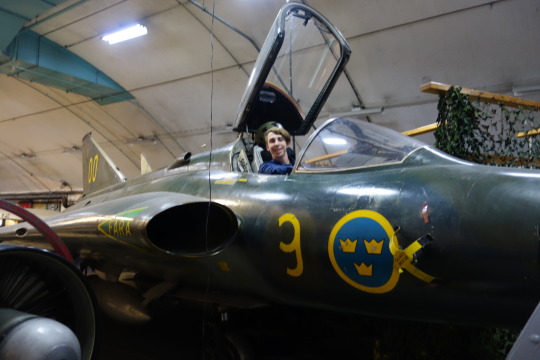
Swedish jet fighters have historically and currently been some of the best fighters in the world. In the Aeroseum(Air Museum), each jet fighter Sweden has developed since their invention.
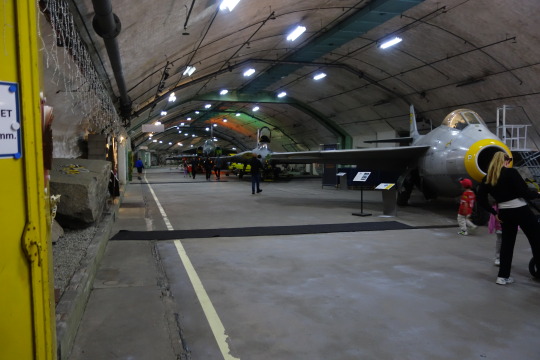
What is just as amazing as the jets is this underground bunker all these planes are stored in. In 1955 they built this bunker so a squadron of planes(40 personnel and 15 Aircraft) would be able to withstand a nuclear blast.
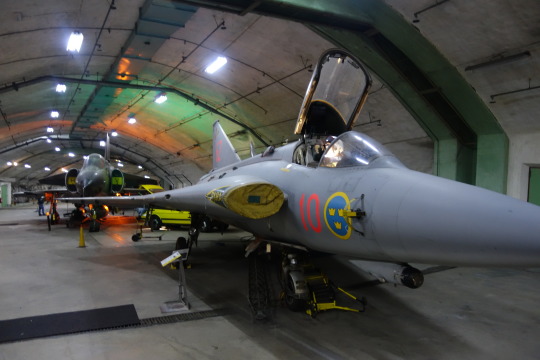
Here's the J35 Draken(Dragon), it's the plane I'm on sitting on in the first picture. Probably the sleekest jet plane I've ever seen and a contender for my favorite jet.

Here's the 37 Viggen, it's the next jet to enter service. While it was built to perform multiple rolls, it was mostly used for maritime reconnaissance. Under it's right wing there is a camera mounted to it.
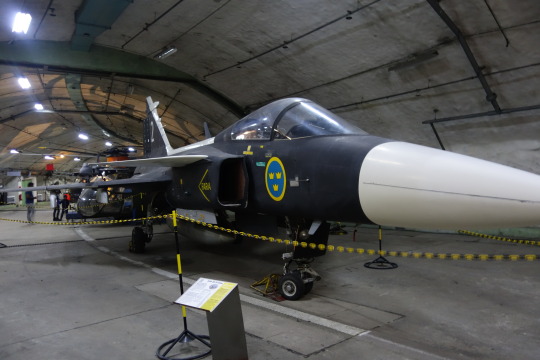
Now this is one mean jet. Introducing the SAAN JAS 39 Grippen. An amazing fighter which was designed, sourced, and built entirely within Sweden.
I'll wrap up this post with a couple more pictures of the Drakken and some other helicopters they had on display.


You'll recognize this helicopter from any Vietnam War movie. Sweden procured many of these from the US for search and rescue.
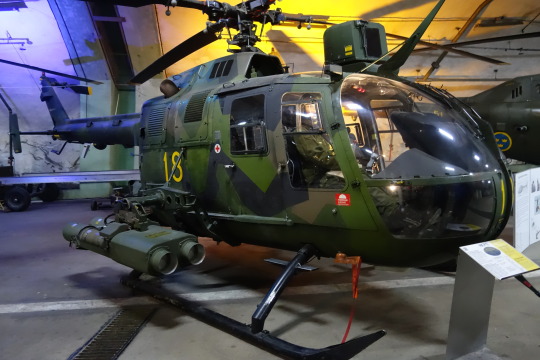
Here is the HKP9. An anti-tank helicopter that can perform a loop.
With this post I am caught up for the moment, tomorrow we'll end up in Jönköping. There should be some really cool and old buildings there!
6 notes
·
View notes
Text
[ad_1] Paromita Das New Delhi. In a landmark development, Bharatiya Prime Minister Narendra Modi and U.S. President Donald Trump have unveiled the U.S.-Bharat COMPACT (Catalyzing Opportunities for Military Partnership, Accelerated Commerce & Technology) initiative. This groundbreaking agreement aims to redefine defense collaboration between the two nations, focusing on technology transfers, co-production ventures, and strategic alignment in defense and security sectors. Strengthening Defense Ties The COMPACT initiative introduces a comprehensive 10-year defense framework, emphasizing joint development and production of advanced defense systems. Notably, Bharat is set to procure and locally manufacture cutting-edge equipment, including the Javelin anti-tank guided missiles and Stryker infantry combat vehicles. The Javelin system, renowned for its fire-and-forget capability and high-explosive anti-tank warhead, has demonstrated exceptional performance in various combat scenarios, including the Iraq war and the ongoing Ukraine-Russia conflict. The Stryker, an eight-wheeled armored vehicle, offers versatility with its Infantry Carrier Vehicle and Mobile Gun System variants, providing robust armor protection and speeds up to 60 miles per hour. Advancements in Aerial Combat A significant aspect of the agreement is the U.S. commitment to reviewing its policy on supplying fifth-generation fighters to Bharat, notably the F-35 Lightning II. This single-seat, single-engine, supersonic stealth fighter is designed for both air superiority and strike missions, encompassing electronic warfare, intelligence, surveillance, and reconnaissance capabilities. While the F-35 is acclaimed as one of the most advanced stealth fighters globally, discussions are also underway for Bharat’s potential involvement in the Next Generation Air Dominance (NGAD) program. This U.S. Air Force initiative aims to develop sixth-generation fighter jets, signaling a forward-looking approach to aerial combat collaboration. Maritime and Autonomous Systems Collaboration The partnership extends to maritime defense, with Bharat set to acquire six additional P-8I Poseidon aircraft. These state-of-the-art maritime patrol aircraft have already proven invaluable in the Indian Navy’s operations. Furthermore, the agreement encompasses collaborations on unmanned surface vehicles (USVs) and autonomous underwater vehicles (AUVs), enhancing underwater domain awareness and maritime security. Industrial Cooperation and Technology Transfer Beyond procurement, the COMPACT initiative emphasizes joint production of defense equipment in Bharat. The formation of the Autonomous Systems Industry Alliance (ASIA) will facilitate collaboration between U.S. companies—such as ThayerMahan, L3Harris, and Anduril—and Bharatiya firms like Mahindra, Bharat Electronics, and Bharat Dynamics. This alliance focuses on co-developing and co-producing maritime drones and counter-drone systems, bolstering indigenous defense manufacturing capabilities. A pivotal component of the agreement is the review of the International Traffic in Arms Regulations (ITAR), which have historically impeded Bharat’s access to critical U.S. military technology. A streamlined ITAR process promises more efficient technology transfers, timely supply of spare parts, and improved maintenance protocols for U.S.-origin equipment in Bharat. Comprehensive Defense Cooperation The COMPACT initiative adopts a holistic approach to modern warfare, encompassing collaborations in space defense, missile defense, and cyber technologies. A notable outcome of the recent discussions is the initiation of negotiations for a Reciprocal Defense Procurement (RDP) agreement. This accord aims to harmonize defense procurement systems, facilitating the mutual supply of defense goods and services. The RDP seeks to streamline procurement processes, reduce bureaucratic obstacles, and enhance efficiency in defense trade. It also aims to facilitate the transfer of advanced technologies, enabling Bharat to locally produce and maintain U.
S.-supplied defense systems. For the U.S., this agreement offers access to cost-effective components from Bharat’s burgeoning defense manufacturing sector. Economic Implications and Future Outlook The U.S. has emerged as a significant buyer of Bharatiya defense products, accounting for nearly 50% of Bharat’s total defense exports. American imports primarily include aircraft and helicopter parts manufactured by Bharatiya firms for global defense majors like Lockheed Martin and Boeing. For instance, Tata Boeing Aerospace Ltd (TBAL) in Hyderabad has supplied over 200 Apache fuselages and other aircraft components, while Lockheed Martin’s partnership with Tata Advanced Systems Limited (TASL) has resulted in the production of more than 200 empennages for the C-130J transport aircraft and over 157 cabins for the S-92 helicopter. These collaborations have contributed to a remarkable surge in Bharat’s defense exports, which soared from $110 million in 2013-14 to over $2.5 billion in 2023-24. This growth aligns with the Modi government’s initiatives, such as “Make in India” and “Atmanirbhar Bharat,” aimed at promoting defense manufacturing and exports. The introduction of the Defence Production and Export Promotion Policy (DPEPP) 2020 and the Strategic Partnership Model has further simplified procurement processes and encouraged private sector participation. Prime Minister Modi has set an ambitious target of achieving $5 billion in defense exports by 2025, driven by a projected $25 billion turnover in defense manufacturing. The recent surge in exports indicates that Bharat is well on its way to meeting this goal. Conclusion The U.S.-Bharat COMPACT initiative signifies a transformative shift in bilateral defense relations, moving beyond traditional buyer-seller dynamics to a partnership rooted in co-development, technology sharing, and strategic alignment. As both nations navigate the complexities of global security challenges, this collaboration not only enhances their defense capabilities but also contributes to regional and global stability. The successful implementation of this initiative will depend on sustained political will, effective execution of agreements, and the fostering of mutual trust and understanding between the two democracies. The post US-Bharat COMPACT: Forging a New Era in Defense Collaboration appeared first on Global Governance News- Asia's First Bilingual News portal for Global News and Updates. [ad_2] Source link
0 notes
Text

A Radar equipped PBY-5A photographed in 1942
#USN#WW2#Navy#Consolidated#PBY#Catalina#PBY-5A#Maritime patrol bomber#Model 28-5A#reconnaissance aircraft#flying boat#vintage aviation
114 notes
·
View notes
Photo
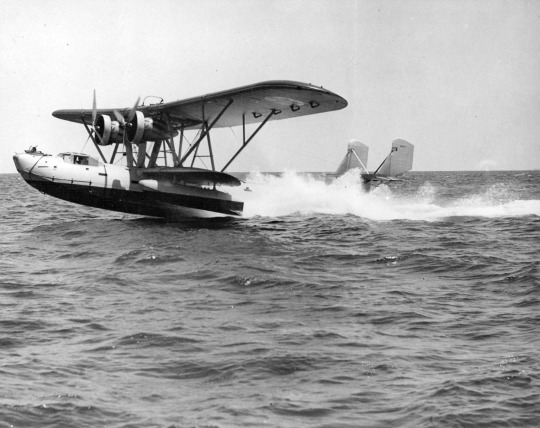
Prototype XP2Y-1 de l'hydravion de patrouille maritime Consolidated P2Y au décollage – 1932
Photographe : US Navy
©National Museum of Naval Aviation - 2010.060.001.014
#Avant-guerre#Pre-war#Marine américaine#US Navy#Aviation militaire#Military aviation#Avion de reconnaissance#Reconnaissance aircraft#Hydravion#Flying Boat#Hydravion de patrouille maritime#Reconnaissance flying boat#Prototype#Consolidated XP2Y-1#Consolidated P2Y#1932
156 notes
·
View notes
Text

4 November 1975. First flight of the Tupolev Tu-142M 'Bear', development of the Soviet maritime reconnaissance and anti-submarine warfare (ASW) aircraft with improved electronic equipment. Powered by four NK-12M turboprop engines.
@ron_eisele via X
28 notes
·
View notes
Text
[ad_1] Paromita Das New Delhi. In a landmark development, Bharatiya Prime Minister Narendra Modi and U.S. President Donald Trump have unveiled the U.S.-Bharat COMPACT (Catalyzing Opportunities for Military Partnership, Accelerated Commerce & Technology) initiative. This groundbreaking agreement aims to redefine defense collaboration between the two nations, focusing on technology transfers, co-production ventures, and strategic alignment in defense and security sectors. Strengthening Defense Ties The COMPACT initiative introduces a comprehensive 10-year defense framework, emphasizing joint development and production of advanced defense systems. Notably, Bharat is set to procure and locally manufacture cutting-edge equipment, including the Javelin anti-tank guided missiles and Stryker infantry combat vehicles. The Javelin system, renowned for its fire-and-forget capability and high-explosive anti-tank warhead, has demonstrated exceptional performance in various combat scenarios, including the Iraq war and the ongoing Ukraine-Russia conflict. The Stryker, an eight-wheeled armored vehicle, offers versatility with its Infantry Carrier Vehicle and Mobile Gun System variants, providing robust armor protection and speeds up to 60 miles per hour. Advancements in Aerial Combat A significant aspect of the agreement is the U.S. commitment to reviewing its policy on supplying fifth-generation fighters to Bharat, notably the F-35 Lightning II. This single-seat, single-engine, supersonic stealth fighter is designed for both air superiority and strike missions, encompassing electronic warfare, intelligence, surveillance, and reconnaissance capabilities. While the F-35 is acclaimed as one of the most advanced stealth fighters globally, discussions are also underway for Bharat’s potential involvement in the Next Generation Air Dominance (NGAD) program. This U.S. Air Force initiative aims to develop sixth-generation fighter jets, signaling a forward-looking approach to aerial combat collaboration. Maritime and Autonomous Systems Collaboration The partnership extends to maritime defense, with Bharat set to acquire six additional P-8I Poseidon aircraft. These state-of-the-art maritime patrol aircraft have already proven invaluable in the Indian Navy’s operations. Furthermore, the agreement encompasses collaborations on unmanned surface vehicles (USVs) and autonomous underwater vehicles (AUVs), enhancing underwater domain awareness and maritime security. Industrial Cooperation and Technology Transfer Beyond procurement, the COMPACT initiative emphasizes joint production of defense equipment in Bharat. The formation of the Autonomous Systems Industry Alliance (ASIA) will facilitate collaboration between U.S. companies—such as ThayerMahan, L3Harris, and Anduril—and Bharatiya firms like Mahindra, Bharat Electronics, and Bharat Dynamics. This alliance focuses on co-developing and co-producing maritime drones and counter-drone systems, bolstering indigenous defense manufacturing capabilities. A pivotal component of the agreement is the review of the International Traffic in Arms Regulations (ITAR), which have historically impeded Bharat’s access to critical U.S. military technology. A streamlined ITAR process promises more efficient technology transfers, timely supply of spare parts, and improved maintenance protocols for U.S.-origin equipment in Bharat. Comprehensive Defense Cooperation The COMPACT initiative adopts a holistic approach to modern warfare, encompassing collaborations in space defense, missile defense, and cyber technologies. A notable outcome of the recent discussions is the initiation of negotiations for a Reciprocal Defense Procurement (RDP) agreement. This accord aims to harmonize defense procurement systems, facilitating the mutual supply of defense goods and services. The RDP seeks to streamline procurement processes, reduce bureaucratic obstacles, and enhance efficiency in defense trade. It also aims to facilitate the transfer of advanced technologies, enabling Bharat to locally produce and maintain U.
S.-supplied defense systems. For the U.S., this agreement offers access to cost-effective components from Bharat’s burgeoning defense manufacturing sector. Economic Implications and Future Outlook The U.S. has emerged as a significant buyer of Bharatiya defense products, accounting for nearly 50% of Bharat’s total defense exports. American imports primarily include aircraft and helicopter parts manufactured by Bharatiya firms for global defense majors like Lockheed Martin and Boeing. For instance, Tata Boeing Aerospace Ltd (TBAL) in Hyderabad has supplied over 200 Apache fuselages and other aircraft components, while Lockheed Martin’s partnership with Tata Advanced Systems Limited (TASL) has resulted in the production of more than 200 empennages for the C-130J transport aircraft and over 157 cabins for the S-92 helicopter. These collaborations have contributed to a remarkable surge in Bharat’s defense exports, which soared from $110 million in 2013-14 to over $2.5 billion in 2023-24. This growth aligns with the Modi government’s initiatives, such as “Make in India” and “Atmanirbhar Bharat,” aimed at promoting defense manufacturing and exports. The introduction of the Defence Production and Export Promotion Policy (DPEPP) 2020 and the Strategic Partnership Model has further simplified procurement processes and encouraged private sector participation. Prime Minister Modi has set an ambitious target of achieving $5 billion in defense exports by 2025, driven by a projected $25 billion turnover in defense manufacturing. The recent surge in exports indicates that Bharat is well on its way to meeting this goal. Conclusion The U.S.-Bharat COMPACT initiative signifies a transformative shift in bilateral defense relations, moving beyond traditional buyer-seller dynamics to a partnership rooted in co-development, technology sharing, and strategic alignment. As both nations navigate the complexities of global security challenges, this collaboration not only enhances their defense capabilities but also contributes to regional and global stability. The successful implementation of this initiative will depend on sustained political will, effective execution of agreements, and the fostering of mutual trust and understanding between the two democracies. The post US-Bharat COMPACT: Forging a New Era in Defense Collaboration appeared first on Global Governance News- Asia's First Bilingual News portal for Global News and Updates. [ad_2] Source link
0 notes
Text
**Biography of the Mexican Navy (Armada de México)**
**Introduction**
The Mexican Navy, known as the Armada de México, is the naval branch of the Mexican Armed Forces. It plays a crucial role in safeguarding the country’s maritime interests, enforcing laws at sea, and contributing to national defense. With a rich history that dates back to the colonial period, the Mexican Navy has evolved into a modern and capable force, reflecting Mexico's strategic priorities and challenges.
**Historical Background**
The origins of the Mexican Navy can be traced back to the early 16th century when Spanish explorers and conquistadors first arrived in the region. The need for maritime defense became apparent as colonial powers vied for control over the New World. The first official naval force was established in 1821, following Mexico's independence from Spain. The newly formed navy faced numerous challenges, including internal conflicts and foreign invasions.
Throughout the 19th century, the Mexican Navy played a significant role in various conflicts, including the Mexican-American War (1846-1848) and the French Intervention in Mexico (1861-1867). During these tumultuous times, the navy was essential in defending the country's sovereignty and territorial integrity.
**20th Century Developments**
The early 20th century saw significant modernization efforts within the Mexican Navy. The establishment of the Navy School in 1884 and the acquisition of modern vessels marked a turning point in the navy's capabilities. The Mexican Navy participated in World War II, contributing to the Allied war effort by patrolling the Gulf of Mexico and the Caribbean Sea.
In the post-war period, the Mexican Navy continued to modernize its fleet and expand its operational capabilities. The navy focused on anti-submarine warfare, coastal defense, and maritime security, adapting to the changing geopolitical landscape.
**Modern Era and Challenges**
In recent decades, the Mexican Navy has faced new challenges, including drug trafficking, organized crime, and environmental threats. The rise of drug cartels has led to increased violence and instability in certain regions, prompting the navy to take on a more active role in domestic security operations.
The Mexican Navy has been involved in various anti-drug trafficking operations, working alongside other law enforcement agencies to combat organized crime. Their efforts have included maritime interdiction operations, surveillance, and intelligence-sharing to disrupt drug smuggling routes.
Additionally, the navy has been actively engaged in humanitarian missions, disaster relief efforts, and environmental protection initiatives. The navy has played a vital role in responding to natural disasters, such as hurricanes and earthquakes, providing assistance to affected communities.
**Current Structure and Capabilities**
Today, the Mexican Navy is composed of several key components, including:
1. **Surface Fleet**: The navy operates a diverse fleet of vessels, including frigates, corvettes, patrol boats, and auxiliary ships. These vessels are equipped with modern technology and weaponry to ensure effective maritime operations.
2. **Naval Aviation**: The Mexican Navy has a dedicated naval aviation branch, operating helicopters and fixed-wing aircraft for reconnaissance, transport, and search-and-rescue missions.
3. **Marine Corps**: The Mexican Marine Corps (Infantería de Marina) is an integral part of the navy, specializing in amphibious operations, coastal defense, and counterinsurgency efforts.
4. **Training and Education**: The Mexican Navy places a strong emphasis on training and education, with institutions such as the Heroico Colegio Naval (Naval Heroic College) providing rigorous programs for future naval leaders.
**Conclusion**
The Mexican Navy has a storied history and a vital role in the country’s defense and security. As it continues to adapt to new challenges, the navy remains committed to safeguarding Mexico's maritime interests, contributing to national security, and promoting regional stability. With its rich heritage and modern capabilities, the Armada de México stands as a testament to the nation's resilience and dedication to protecting its sovereignty on the seas.
0 notes
Text

Vickers Wellesley medium bomber, an interwar design that served in peripheral theaters during the early years of WWII. The Wellesley was operated overseas in the desert theatres of East Africa, Egypt and the Middle East. The final Wellesley-equipped unit, 47 Squadron, ended its use of the type as a maritime reconnaissance aircraft, during September 1942.
21 notes
·
View notes